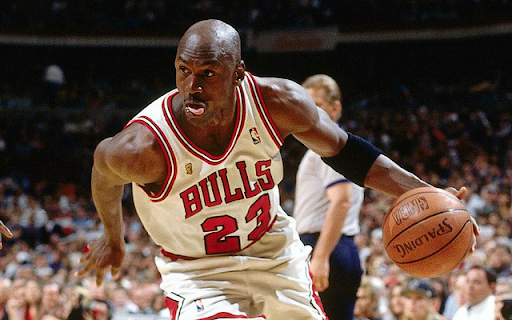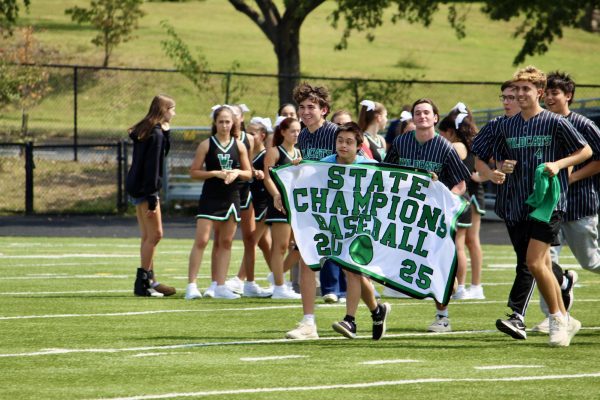Top moments and biggest takeaways from “The Last Dance”

Photo courtesy of Flickr
Michael Jordan drives to the basket in another pivotal game in his remarkable career. “The Last Dance” gave fans an inside look at the legendary Bulls dynasty.
Jun 1, 2020
Sunday at 9 p.m. Three simple words that carried a deep mutually understood meaning throughout the nation. For the past month, that has been the day and time that athletes and fans around the country tuned in to watch the ESPN documentary “The Last Dance”.
The documentary provides an inside look at the historic Bulls dynasty with a focus on the players and people that played an important role, and particularly Michael Jordan. Over the course of the past couple weeks, fans watched as ESPN showcased the journey of Jordan and a once mocked Bulls squad as they rose to become the well respected, six time champions that cultivated fans around the world and dominated the NBA in the 90’s.
Many may have claimed to know the full story of the Bulls dynasty. Any fan could tell you about the games, the greatness of Jordan and the team that won six titles. However “The Last Dance” was a lot more than that. It gave an in-depth look at all components of the dynasty and showed content and reactions that were never seen before. It is safe to say that no fan could possibly know the full story until watching “The Last Dance”.
As an avid NBA fan myself, I have been watching basketball since I first learned to walk. In fact, one of my first baby pictures has me sporting a red Shaquille O’Neal Miami Heat jersey. I have seen great players and dynasties that have captured my attention through the years. There was the Kobe Bryant led Lakers, challenged of course by the Celtics with Paul Pierce, Kevin Garnett and Rajon Rondo. There was the Miami Heat dynasty with LeBron James, Dwyane Wade and Chris Bosh, and of course the Golden State Warriors dynasty with Stephen Curry, Klay Thompson and Kevin Durant that has drawn comparisons to the very Bulls team featured in the documentary. Therefore, when ESPN announced they would be releasing “The Last Dance” on the Bulls dynasty, I knew I had to watch.
My generation has grown up watching the dominance of LeBron as well as the all mighty Golden State Warriors dynasty. Before “The Last Dance”, it was a safe bet that many basketball fans who had grown up in this era had not watched all of the games from the 90s and knew MJ mainly for the crying meme or when he infamously said “the ceiling is the roof”. Jordan and the Bulls were respected, but there was still debate and comparisons being drawn. While the talent of today is still certainly among the greatest, “The Last Dance” shows the dominance that puts the Bulls and Jordan into their own category. Here are some great moments from the series and what I gathered from them:
1. 1991 ECF Game 4: Pistons don’t shake hands
After multiple playoff exits at the hands of the “bad boy” Pistons, Jordan and the Bulls finally overcame their nemesis with a sweep in the 1991 Eastern Conference Finals. The Pistons were a tough team and had used tactics such as the “Jordan Rules” in an attempt to keep the Bulls grounded, but it was the Bulls in 1991 who would advance to the finals and win their first NBA title. After the loss in the ECF, the Pistons stars, led by Isiah Thomas, decided to leave the court early and refused to shake hands. While this was undoubtedly very unsportsmanlike, it showed just how deeply rooted the rivalry between the two squads was and it was the first big hurdle for the Bulls in becoming a greater team. Interviews with Jordan and Thomas in “The Last Dance” show that there is still bad blood between the teams even to this day, which is a testament to how physical and heated the series got.
2. Don’t get on MJ’s bad side
Jordan played with a high intensity throughout his career, but what amazed me most was his ability to motivate himself. Jordan would use anything and everything as fuel for his game. There was not one scenario where Jordan wanted anyone else to have anything on him and it is that mentality that kept him pushing for more. Therefore, if you got on his bad side, he seeked revenge.
On March 19 and 20 of the 1993 season, the Bulls had a back-to-back against the Bullets. In the first game in Chicago, second year guard LaBradford Smith put up a career high 37 points against Jordan in the best game of his career. While the Bulls still won, the fact that Smith had a better game made it personal for Jordan. It only took one player in a game that he won for Jordan to seek out vengeance. In fact, Jordan revealed in “The Last Dance” that he made up a story in his head that Smith came up to him post-game, stuck out his hand and said “Good game, Mike” simply to add fuel to his fire. The very next night Jordan was shooting in the arena early before the game and would dominate Smith as he put up 36 points, one shy of Smith’s 37 from last game, in only the first half. Jordan would finish with 47 points through three quarters and Smith had 15 points in the game as the Bulls won by 25.
Another example came before the first game of the 1996 NBA Finals. Jordan and the Bulls were set to face off against the Seattle Supersonics who had 64 wins and were led by Gary Payton. The coach of the Supersonics, George Karl, was from North Carolina, where Jordan played collegiate basketball, and the two had played golf together in the past. “The Last Dance” goes into depth revealing that the two were actually at the same restaurant before the start of the series and instead of saying “Hello” to Jordan, Karl actually ignored him and walked right past his table. It was at that moment that Jordan got all the fuel he needed and the series became personal. The Bulls would go on to win the finals that year, the first of their second three-peat, defeating the Sonics in six games. It is incredible to me that Jordan can turn up his game to such a high intensity with the driving motivational factor being that he was ignored.
3. Jordan wins 1996 Finals on Father’s Day
Truly the most powerful moment of the documentary was watching Jordan win the 1996 Finals on June 16, Father’s Day. Three years earlier on July 23, 1993, James Jordan, Michaels’ father, was murdered in a carjacking in North Carolina. Jordan’s father was his biggest supporter and a man who had a great influence on his life. James could always be seen next to Michael after he won his titles. After the tragic death, MJ went on to play baseball, something his father wanted him to do. The championship in 1996 was the first title he won without his dad being present. The emotions shown after the game is one of the most moving scenes of “The Last Dance”, in which MJ was on the locker room floor in tears. This showed not only his heart for the game, but the true impact of his father and what it meant to win without him there.
4. Bloody sock? No problem.
On March 8, 1998, Jordan played his last game at Madison Square Garden as a Chicago Bull. MSG has always been known as a famous arena for sports and an iconic venue for concerts. Jordan loved playing there and to pay homage, he wore a pair of Air Jordans from 1985. Unfortunately they were a size 12.5 and Jordan’s feet were a size 13.5 in 1998.
“By halftime my feet are bleeding, but I’m having a good game, I don’t want to take them off,” Jordan said on “The Last Dance”.
Jordan would explode for 42 points, his socks soaked in blood after the game. Most players would simply change shoes, even in the middle of a good game, but this was yet another example of how Michael Jordan is not most players. The ability to score over 40 points through bloody feet is a remarkable feat on its own, however; the essence of keeping them on shows his competitive nature. If it wasn’t broken, Jordan wasn’t going to fix it. In other words, if changing the shoes meant even a slight chance of breaking his game, there was no way he was going to change them no matter what the cost.
5. 23 to 45 to 23
After 17 months of retirement to play baseball, Jordan returned to basketball. Not wanting to play professional basketball in his number 23 without his father there, Jordan started a new beginning with his high school number, 45. In the 1995 Eastern Conference semis against the Orlando Magic, Jordan choked on a late possession and the Magic took the first game of the series. After the game Nick Anderson had some choice words for Jordan. In “The Last Dance”, his teammate Horace Grant, a former teammate of Jordan on the Bulls, quoted him as saying:
“45 isn’t 23”.
As we know, getting on Jordan’s bad side would only provide more fuel. In the next game of the series Jordan came in wearing 23 and scored 38 points as the Bulls evened the series. He received a $25,000 fine from the league for his actions but nevertheless, 23 was back. The Bulls would go on to lose the series but this showed once again the competitive nature and relentlessness of Jordan.
6. “The Flu Game”
The 1997 NBA Finals series between the Chicago Bulls and Utah Jazz was tied 2-2 and a pivotal game five was ahead. Jordan and the Bulls had a chance to go up 3-2 and win the title at home. It was the night of June 10, 1997, one day before game five. Jordan, Goerge Koehler (personal assistant) and Tim Grover (personal trainer) reveal on “The Last Dance” the story of how MJ got food poisoning from a strange pizza delivery while at a hotel in Utah. Jordan was hungry late at night and thus ordered pizza from the only place that was open. When the food arrived, five delivery men showed up, which Koehler and Grover express in their interviews on “The Last Dance” was a bad sign. After eating the pizza, Jordan got sick and it was questionable whether he would play in game five. Nevertheless, after a day of little eating and missing the shoot around, Jordan started the game. It was a rocky start, but despite the exhaustion and flu-like symptoms he faced, MJ would go on to score 38 points in 44 minutes and hit a clutch three pointer at the end of the game as the Bulls went on to win 90-88 and take a 3-2 series lead. They would win the next game in Chicago to clinch the NBA title and fifth for Jordan and the Bulls franchise. The flu game stands out because you could see that Jordan would let nothing stop him or get in the way of him and the championship. He had a will to win that was unmatched.
“He had shown that no matter how sick he was, he’s still the best player in the world,” Scottie Pippen said in “The Last Dance”.
During one of the final timeouts, you can see the toll the game has taken on MJ, and Scottie Pippen is seen helping carry him to the bench. This moving scene presents the bond between the teammates as well as the fight within each of them.
7. MJ laughs at Hall of Famer Gary Payton
In the 1996 NBA Finals, Jordan led the Bulls to a commanding 3-0 lead. Gary Payton, who had won Defensive Player of the Year that season, was not put on Jordan. Sonics coach George Karl was afraid that would cost them Payton’s scoring abilities.
It was after the third straight loss that Payton decided he was going to guard Jordan regardless. The Supersonics won the next two games and the series was seemingly starting to shift. Nevertheless, Jordan would lead the Bulls to their pivotal win on June 16 to clinch another NBA title but it begs the question of what could have happened if Payton was on Jordan from the start of the series.
When reflecting on it during “The Last Dance”, Payton talks about how he didn’t back down to Jordan. Payton said that his physicality “took a toll on Mike”.
The producers of the show then brought the video of Payton’s interview to Jordan who simply laughed it off.
“I had no problem with Gary Payton,” Jordan said in “The Last Dance”.
This moment is iconic for so many reasons. First, it shows Jordan’s mentality. MJ didn’t want any player to have anything on him and it carries through to this day when he laughs at Hall of Famer Gary Payton. Not many players can laugh at a Hall of Famer, which is a testament to Jordan’s competitive nature and greatness as a basketball player. It also shows that much like the rivalry with the Pistons, these grudges still very much live on to this day.
After watching the documentary, it is clear to me that MJ and the Bulls are simply unparalleled. Their greatness in terms of what they achieved and how they went about it is inspiring. There is no player like Michael Jordan or team like that Bulls squad and there may never be.





















